The other Georgiana Molloy
When Georgiana Molloy died in April 1843 her last surviving daughter, named after her, was just six months old. The other Molloy sisters could be cared for by their father at Fairlawn but she was not old enough to be weaned. Mary Ann Heppingstone née Bayliss, widow of George Layman of nearby Wonnerup, had married Robert Heppingstone Jr and their son was born just two days before baby Georgiana so, after her mother’s death, she went to live with the Heppingstones. The kind woman who took her in, once known as Mrs Layman, was referred to afterwards by the Molloy family as Georgiana’s ‘foster mother’.
Mary Ann and her husband, George Layman, had lived as close neighbours of the Molloys in the small British settlement at Taalinup (Augusta). George was there from 1831, working as a builder. In 1832, along with John Garrett Bussell and others, he was allocated a large grant of land further north at the what the British colonists called ‘the Vasse’. When most of the Augusta settlers decided to relocate to that region (Undalup and Yonderup) in 1835, George wrote to the Colonial Secretary expressing his concerns about the safety of his young family and asked if there was a way he could exchange some of the land he had previously been allocated in Augusta for a smaller block in a safer place on the ‘left bank’ of the Vasse river, close to where four soldiers lived at the ‘Yonderup station’, what would soon be known ‘Soldier Point’. It was the same place on the bend of the river where the three Chapman brothers and Elijah Dawson (previously John Molloy’s indentured servant) had already settled on the other bank. It looked like a good place to live and farm on a small-holding. The river was navigable in a small boat and was a source of fresh water and fish, as recounted in several contemporary diaries.
April 7th 1835 George Layman to the Hon. J. S. Roe Esq.
I should be very much obliged if you would request the Governor to grant me about ten or twelve acres of land at the Vasse on the opposite side if the river to that which His Excellency was so kind as to give the Messrs Chapman, as I intend removing with my family to the Vasse when Mr Bussell goes.
My 500 acre grant is situated three miles from any neighbour, and the natives have lately been rather hostile.
I hope His Excellency will grant me this favour as it would not be safe for me to so far off unprotected should the natives at any time attack us.
Layman wasn’t granted the land he requested because government red tape meant he was too late to apply under previous regulations but he was given the opportunity to purchase three four-acre allotments at his well-chosen site, a total of twelve acres to be offered to him in the form of a square for his ‘convenience’, at the rate of one British pound per acre. And so, the Laymans’ first home after leaving Augusta was not the place we know today as Wonnerup House but a small cottage he built close to the river’s edge on what became Sussex Location B4. In 1836, the only settlers in the entire Vasse region were the Laymans and their children, the Dawson family, the three Chapman brothers all living on small allotments on the bend of the Vasse river, and the Bussells and Molloys on their larger grants, with their houses being about 1.5 kilometres away but within hearing distance if a gun was fired. In a diary that recounts his arrival at Yonderup in December 1836, Lieutenant Henry Bunbury notes that Elijah Dawson, George Layman (with one man working for him) and the Chapman brothers were ‘all herded together’ with the Bussells. Layman’s boundary adjoined the fenced boundary of the Bussell land at that time, which stopped at the river bank. Bunbury notes that they ‘all had a few cattle’, and they ‘subsisted on the produce of the sale of their potatoes and butter, and on the payment for work done for the Messers. Bussell’.
A few weeks ago, I went to Busselton to visit the site where George built his cottage at some point in 1835-1836 when he finally managed to find the money the Colonial Secretary required. Most of that land has been developed now but the place where the Layman cottage once stood is not in private ownership so I was able to walk there. It was a warm and sunny winter day but as I wandered among the native trees, the stillness and absence of noise seemed extraordinary for a place at the heart of a busy country town and I had a strong sense of what it must have been like for the three families who made their homes there for a while.
Contemporary survey maps indicate fairly accurately where the cottage was sited, and I was surprised (when I stood on the very spot) how close to the river bank the family lived, even though that makes sense for the availability of fresh water and access for travelling around the area in a small boat. I wasn’t expecting to see the other side of the river so very close, less than a stone’s throw. The Dawsons and Chapmans would have known when the Laymans sneezed, perhaps an unwelcome feeling today but, in 1836, preferable to the silence of isolation. The house was tucked on the corner of a sharp bend, almost like a promontory, with the river on two sides, behind it enough land to grow all the food they needed to survive if they planted intensively and space to pasture the stock they kept for milk and meat. The trees around the house site now are recent plantings and even the figs along the river banks are much too young to date from the time of the Laymans but there are some things that have not changed at all: the sound of the wind being pulled along the river, loudly rustling ancient trees on its banks, and the birds that announced their disdain as I disturbed them, the same sounds the Layman family heard when they worked in the garden on a July day in 1836; the sharp smell of wet eucalyptus leaves underfoot and the sweet fragrance of honey in the air, early Wattle flower; the babbling of the river moving over flat, granite rocks the settlers had placed there to make a safe stepping place when summer lowered the river’s flow and made it easier to wade across from one home to the other.
It seemed like an idyllic place for a family but the Laymans and their two infant daughters did not stay long in their new home. In 1837, while Elijah Dawson (now appointed Constable in Busselton) and his heavily pregnant wife were inside their cottage eating breakfast just a few metres away from the Laymans, their cottage was attacked by a large group of Wadandi men. Glass was hard to get hold of and very expensive so their windows were covered only in sheer cambric fabric to keep out flies and snakes while allowing light to pass through. Nugundung, a local Wadandi man, threw a spear through the window. It just missed Ann but another wounded Elijah in the arm.
Only two days earlier, the Vasse settlers had met to discuss whether they should abandon their homes and group together for safety but decided against that and agreed on ‘a code of gunshot signals to apprise each other of danger’. (The West Australian Nov 1913 Obituary of G W Dawson) Elizabeth Capel (Bessie) Bussell wrote in her diary at Cattle Chosen on Wednesday 13th July that ‘about twelve o’clock’ the Chapmans ‘fired two guns which were preceded by a terrible scream heard alone by Mamma’.
‘Everyone immediately armed themselves. When they arrived they found that Dawson had been speared in the arm & that they had thrown another spear at Mrs Dawson they think it most prudent to leave their house & come under our protection they have taken possession of our servants’ cottage’
John Garrett Bussell’s daughter, Josephine, recalled hearing about the incident during her childhood.
‘Old Elijah Dawson had a house near the bend of the river near James Street, and he and his family lived there. One day, in the daytime, about 50 natives came throwing spears near the window and one spear went right through a calico window into the wall on the opposite side. Mr Dawson caught a spear in the arm. Then he moved his house as he was afraid to live there any longer and he went to Cattle Chosen to live.’
The reminiscences of Mrs Prinsep (Charlotte Josephine Bussell) daughter of John Garrett Bussell, who was interviewed at Little Holland House, Busselton in February, 1928 by Paul Hasluck.
The Dawsons fled immediately to the safety of the Bussell house about a kilometre away at Cattle Chosen. The next day, the three Chapman brothers also abandoned their home on the river and arrived there too. They moved into Lenox Bussell’s cottage on the Bussell property. Two days later, the Bussell’s servant said she had seen Gaywal [i] (Nugundung’s father-in-law) and other ‘warriors’ in red war paint near the house but when others arrived and announced themselves as friends ‘they were believed for everyone is so very unwilling to take away life.’ (Diary of Elizabeth Capel Bussell 1837) Elijah survived his wounds and his son, George Wakeham Dawson, was born at Cattle Chosen three weeks later.
In 1840, John Garret Bussell referred to the same incident when he wrote to the Colonial Secretary to explain why he had arrested Nugundung when he bumped into him at Picton.
‘The prisoner is the individual that attempted the life of the Constable’s wife at Busselton in the year 1837, by throwing his spear through her window, while her husband was wounded in the arm by another native at the same moment. He also is guilty of the murder of Mr. Layman’s cowherd at Wanerup, in the immediate vicinity of the house.’
E O G Shann, ‘Cattle Chosen The story of the first group settlement in Western Australia 1829 to 1841 oxford University Press London
In August, the Chapmans and Dawsons moved away from the Bussell home to their own land grants near Wonnerup. The four soldiers at Soldier Point had been moved away and with the military attachment, small as it was, now much closer to Wonnerup than the Vasse/Busselton townsite. George Layman settled his family on their 500 acre land grant at Wonnerup, nearer the Vasse estuary where, in 1841, Lieutenant Northey would be in charge of seven soldiers at the new barracks. The property George built there became known as Wonnerup Dairy. Rebuilt and extended after a fire, it would be home for several generations of Laymans. In 1843, it became the temporary, and perhaps lifesaving, home of Georgiana Molloy’s youngest daughter, a baby in need of a mother.
George’s abandoned cottage on the bank of the Vasse river must have been encircled by the outcomes of the family’s labours during the two years they lived there, doubtless a densely planted vegetable garden and grazing paddocks for their stock. Until 1839, Henry Mortlock Ommaney’s survey maps show the owner of Sussex Location B4 as Layman. The proposed site for a church and clergyman’s dwelling on the Busselton townsite in August 1842 still shows the land at B4 as owned by Layman, more than a year after his death, fatally speared by Gaywal at Wonnerup.
The old Layman block by the river was close to the boundary of John Molloy’s land. At some point between 1840 and 1841, and shown in subsequent surveys and financial records, Molloy purchased it. He wrote to his daughter, Sabina, in 1853 about a cottage he owned there that might be of interest to her.
‘you remember the 12 acres of Town land I bought of Layman a tolerably commodious cottage will be disposable there’
Although the cottage is still recorded as ‘Layman’s’ in the 1839-1844 survey map (probably a local, historical name for the house) the owner of B4 is shown clearly as Molloy.
After John Molloy’s death, Lionel Samson (who was his executor) purchased Sussex location B4. By that time, the cottage had three additional rooms ‘built into the verandah’ and was in ‘very good repair’. The two rooms ‘built with stone’ (presumably the original rooms when George and Mary Ann Layman lived) were twelve feet square and twelve feet by fifteen feet.
Opinion and valuation of the late Lieut. Colonel Molloy’s property at the Vasse by David Edle for W P Clifton, Leschenault Cottage, Bunbury Sept. 4th 1868 With thanks to Patrick Richardson-Bunbury for an original typescript of this document.
Today, what was most of Sussex location B4 has been subdivided and is occupied by businesses and private homes in Busselton’s light industrial area, but modern development reveals to us once again, after more than a hundred and eighty years, the original boundaries of the three allotments George Layman purchased. The Busselton Shire works to maintain and sustain the ecological health and viability of the Vasse river and has retained ownership of a narrow strip of land on the edges of Sussex Location B4 where George and Mary Ann built the stone, two-roomed cottage that, despite their more widely known connection with Wonnerup, was their first home in Busselton.
[i] Several alternative spellings are used to represent, in written English orthography, the phonemes of the Wadandi Noongar spoken name

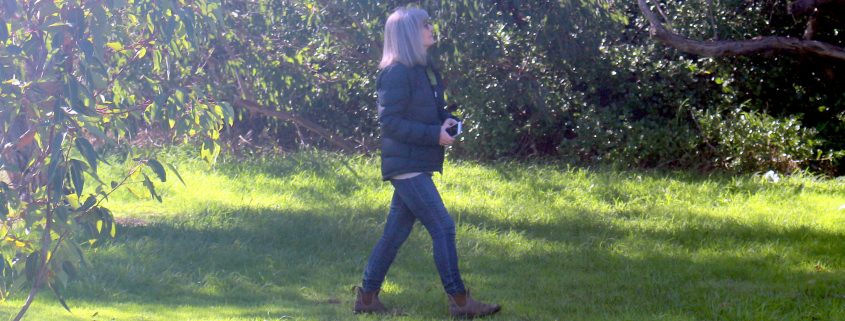
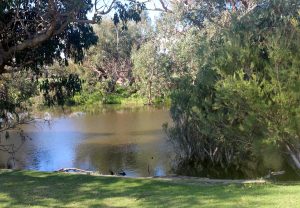
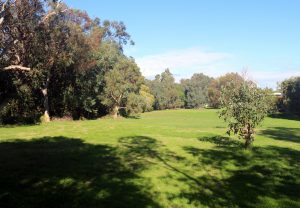
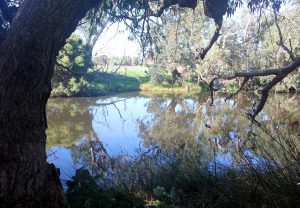
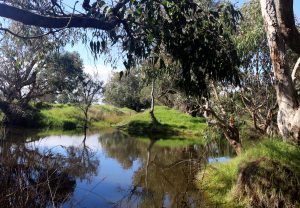
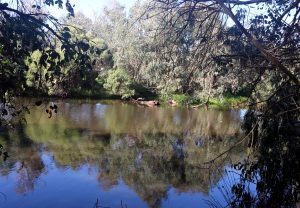
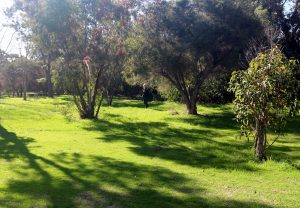
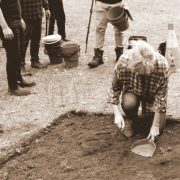
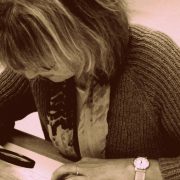
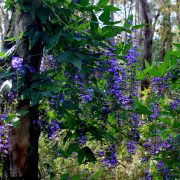

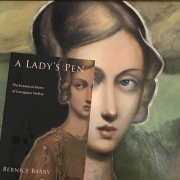
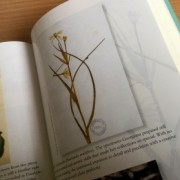
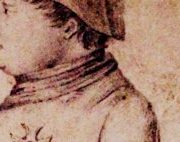
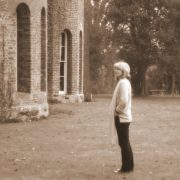


Thank you so much I do enjoy being taken back to the days of Georgiana’s descendant’s and the early days of south/west Australia. I live in Victoria but have a niece living in Denmark, Australia..
You must feel very close to Georgiana having spent so much time studying her history. I must say it’s been a great pleasure for me also. Thanks for the email, Jenny Sadler
Thanks so much, Jenny, and yes – I do enjoy the time I spent doing the research. I love being in archives and libraries but, most of all, I like to follow original footsteps and walk on the same country, seeing and hearing some of the same things. There are still a few things that don’t change over time.